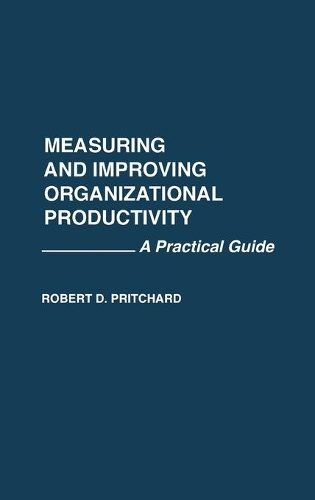
Measuring and Improving Organizational Productivity: A Practical Guide
(Hardback)
Publishing Details
Measuring and Improving Organizational Productivity: A Practical Guide
By (Author) Robert Pritchard
Bloomsbury Publishing PLC
Praeger Publishers Inc
26th November 1990
United States
Classifications
Tertiary Education
Non Fiction
658.515
Physical Properties
Hardback
264
Width 156mm, Height 235mm
595g
Description
Productivity has become a national priority. Its effects are being felt on all levels--national, industrial, and individual. An organization must be able to measure productivity before effectively improving it. This volume is the first practical guide for developing productivity measurement systems. It describes the use of the Productivity Measurement and Enhancement System (ProMES) designed by its author and his colleagues. An important tool for organizations, this step by step guide discusses how to measure productivity and then how to use this measurement. Robert Pritchard's guide first presents a detailed description of the development and uses of ProMES. The background and description of ProMES is followed by details on how to develop ProMES in any organization. Questions and answers about using the system are discussed together with further issues on how to implement the system. The use of the system with other productivity improvement techniques is also covered. The volume concludes with a discussion on evaluating the effects of a productivity improvement system. It is a valuable practical source for industrial and organizational psychologists, management consultants, classes, and workshops.
Reviews
For the reader who elects to use the productivity, easurement and enhancement (Promes) system developed by the author and his associates, or for the reader simply seeking a system, this book provides a precise description and practical guide. The step-by-step presentation offers a logical sequence form definition through installation and critique. One troubling issue throughout the discussion is the subordination of qualitative issues to quantitative measures. There is also some awkwardness in dealing with the motivational aspects of productivity measures; this is reflected in the relatively brief treatment in the introductory chapters, the fairly simplistic measures described in Appendix G, and the limited number of management references cited. Seven appendixes provide graphic examples illustrating the installation and evaluation process. Extensive industrial/organizational psychology reference list; well-ordered index. This clear and practical guide will be of value to both practitioners and students of production/operations management and industrial/organizational psychology.-Choice
Productivity has become a national priority whose effects are being felt on all levels-national, industrial, and individual. An organization must be able to measure productivity before effectively improving it. This volume is the first practical guide for developing productivity measurement systems and describes the use of the Productivity Measurement and Enhancement System (ProMES) designed by its author and his colleagues. This detailed guide is a valuable source for organizational psychologists, management consultants, classes, and workshops.-The ABA Newsletter
"Productivity has become a national priority whose effects are being felt on all levels-national, industrial, and individual. An organization must be able to measure productivity before effectively improving it. This volume is the first practical guide for developing productivity measurement systems and describes the use of the Productivity Measurement and Enhancement System (ProMES) designed by its author and his colleagues. This detailed guide is a valuable source for organizational psychologists, management consultants, classes, and workshops."-The ABA Newsletter
"For the reader who elects to use the productivity, easurement and enhancement (Promes) system developed by the author and his associates, or for the reader simply seeking a system, this book provides a precise description and practical guide. The step-by-step presentation offers a logical sequence form definition through installation and critique. One troubling issue throughout the discussion is the subordination of qualitative issues to quantitative measures. There is also some awkwardness in dealing with the motivational aspects of productivity measures; this is reflected in the relatively brief treatment in the introductory chapters, the fairly simplistic measures described in Appendix G, and the limited number of management references cited. Seven appendixes provide graphic examples illustrating the installation and evaluation process. Extensive industrial/organizational psychology reference list; well-ordered index. This clear and practical guide will be of value to both practitioners and students of production/operations management and industrial/organizational psychology."-Choice
Author Bio
ROBERT D. PRITCHARD is Professor of Psychology and Director of the Industrial and Organizational Psychology Program at Texas A&M University. His primary interest lies in measuring and improving organizational productivity. He has worked with many organizations in the United States and Europe. He is a member of a national task force on productivity and the Governor's Committee on Incentive and Productivity in Texas. Pritchard has published numerous articles on the topic of productivity.
